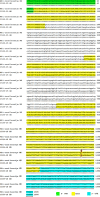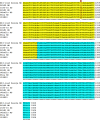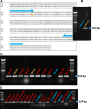A R2R3-MYB gene-based marker for the non-darkening seed coat trait in pinto and cranberry beans (Phaseolus vulgaris L.) derived from 'Wit-rood boontje'
- PMID: 32112124
- PMCID: PMC7237406
- DOI: 10.1007/s00122-020-03571-7
A R2R3-MYB gene-based marker for the non-darkening seed coat trait in pinto and cranberry beans (Phaseolus vulgaris L.) derived from 'Wit-rood boontje'
Abstract
The gene Phvul.010G130600 which codes for a MYB was shown to be tightly associated with seed coat darkening in Phaseolus vulgaris and a single nucleotide deletion in the allele in Wit-rood disrupts a transcription activation region that likely prevents its functioning in this non-darkening genotype. The beige and white background colors of the seed coats of conventional pinto and cranberry beans turn brown through a process known as postharvest darkening (PHD). Seed coat PHD is attributed to proanthocyanidin accumulation and its subsequent oxidation in the seed coat. The J gene is an uncharacterized classical genetic locus known to be responsible for PHD in common bean (P. vulgaris) and individuals that are homozygous for its recessive allele have a non-darkening (ND) seed coat phenotype. A previous study identified a major colorimetrically determined QTL for seed coat color on chromosome 10 that was associated with the ND trait. The objectives of this study were to identify a gene associated with seed coat postharvest darkening in common bean and understand its function in promoting seed coat darkening. Amplicon sequencing of 21 candidate genes underlying the QTL associated with the ND trait revealed a single nucleotide deletion (c.703delG) in the candidate gene Phvul.010G130600 in non-darkening recombinant inbred lines derived from crosses between ND 'Wit-rood boontje' and a regular darkening pinto genotype. In silico analysis indicated that Phvul.010G130600 encodes a protein with strong amino acid sequence identity (70%) with a R2R3-MYB-type transcription factor MtPAR, which has been shown to regulate proanthocyanidin biosynthesis in Medicago truncatula seed coat tissue. The deletion in the 'Wit-rood boontje' allele of Phvul.010G130600 likely causes a translational frame shift that disrupts the function of a transcriptional activation domain contained in the C-terminus of the R2R3-MYB. A gene-based dominant marker was developed for the dominant allele of Phvul.010G130600 which can be used for marker-assisted selection of ND beans.
Figures






Similar articles
-
Proanthocyanidin biosynthesis and postharvest seed coat darkening in pinto bean.Phytochem Rev. 2025;24(4):2445-2461. doi: 10.1007/s11101-023-09895-8. Epub 2023 Oct 12. Phytochem Rev. 2025. PMID: 40792059 Free PMC article. Review.
-
Mapping the non-darkening trait from 'Wit-rood boontje' in bean (Phaseolus vulgaris).Theor Appl Genet. 2018 Jun;131(6):1331-1343. doi: 10.1007/s00122-018-3081-y. Epub 2018 Mar 3. Theor Appl Genet. 2018. PMID: 29502138
-
Proanthocyanidin accumulation and transcriptional responses in the seed coat of cranberry beans (Phaseolus vulgaris L.) with different susceptibility to postharvest darkening.BMC Plant Biol. 2017 May 25;17(1):89. doi: 10.1186/s12870-017-1037-z. BMC Plant Biol. 2017. PMID: 28545577 Free PMC article.
-
Genome-wide association mapping reveals new loci associated with light-colored seed coat at harvest and slow darkening in carioca beans.BMC Plant Biol. 2021 Jul 20;21(1):343. doi: 10.1186/s12870-021-03122-2. BMC Plant Biol. 2021. PMID: 34284717 Free PMC article.
-
Genome-wide identification of Pistacia R2R3-MYB gene family and function characterization of PcMYB113 during autumn leaf coloration in Pistacia chinensis.Int J Biol Macromol. 2021 Dec 1;192:16-27. doi: 10.1016/j.ijbiomac.2021.09.092. Epub 2021 Sep 20. Int J Biol Macromol. 2021. PMID: 34555399 Review.
Cited by
-
Genome-Wide Association Study to Identify Possible Candidate Genes of Snap Bean Leaf and Pod Color.Genes (Basel). 2023 Dec 18;14(12):2234. doi: 10.3390/genes14122234. Genes (Basel). 2023. PMID: 38137056 Free PMC article.
-
Sensory properties of selected biofortified common bean (Phaseolus vulgaris) varieties grown in Burundi.Food Sci Nutr. 2024 Feb 13;12(5):3199-3213. doi: 10.1002/fsn3.3988. eCollection 2024 May. Food Sci Nutr. 2024. PMID: 38726439 Free PMC article.
-
Proanthocyanidin biosynthesis and postharvest seed coat darkening in pinto bean.Phytochem Rev. 2025;24(4):2445-2461. doi: 10.1007/s11101-023-09895-8. Epub 2023 Oct 12. Phytochem Rev. 2025. PMID: 40792059 Free PMC article. Review.
-
Construction of a high-density genetic map for yardlong bean and identification of ANT1 as a regulator of anthocyanin biosynthesis.Hortic Res. 2023 Nov 27;11(1):uhad247. doi: 10.1093/hr/uhad247. eCollection 2024 Jan. Hortic Res. 2023. PMID: 38274647 Free PMC article.
-
QTL Mapping of Seed Quality Traits Including Cooking Time, Flavor, and Texture in a Yellow Dry Bean (Phaseolus vulgaris L.) Population.Front Plant Sci. 2021 Jun 22;12:670284. doi: 10.3389/fpls.2021.670284. eCollection 2021. Front Plant Sci. 2021. PMID: 34239523 Free PMC article.
References
-
- Aasland R, Gibson TJ, Stewart AF. The PHD finger: implications for chromatin-mediated transcriptional regulation. Trends Biochem Sci. 1995;20:56–59. - PubMed
-
- Albert NW, Griffiths AG, Cousins GR, Verry IM, Williams WM. Anthocyanin leaf markings are regulated by a family of R2R3-MYB genes in the genus Trifolium. New Phytol. 2015;205:882–893. - PubMed
-
- Amador V, Monte E, Garcia-Martinez JL, Prat S. Gibberellins signal nuclear import of PHOR1, a photoperiod responsive protein with homology to Drosophila armadillo. Cell. 2001;106:343–354. - PubMed
MeSH terms
Substances
LinkOut - more resources
Full Text Sources

